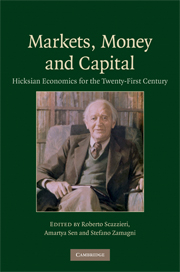Book contents
- Frontmatter
- Contents
- List of figures
- List of tables
- List of contributors
- Preface and acknowledgments
- Between theory and history: on the identity of Hicks's economics
- Part I The Intellectual Heritage of John Hicks
- Part II Markets
- 7 Hicks and the emptiness of general equilibrium theory
- 8 Hicks versus Marx? On the theory of economic history
- 9 Hicks's notion and use of the concepts of fix-price and flex-price
- 10 On the Hicksian definition of income in applied economic analysis
- Part III Money
- Part IV Capital and Dynamics
- References
- Name index
- Subject index
10 - On the Hicksian definition of income in applied economic analysis
Published online by Cambridge University Press: 29 June 2009
- Frontmatter
- Contents
- List of figures
- List of tables
- List of contributors
- Preface and acknowledgments
- Between theory and history: on the identity of Hicks's economics
- Part I The Intellectual Heritage of John Hicks
- Part II Markets
- 7 Hicks and the emptiness of general equilibrium theory
- 8 Hicks versus Marx? On the theory of economic history
- 9 Hicks's notion and use of the concepts of fix-price and flex-price
- 10 On the Hicksian definition of income in applied economic analysis
- Part III Money
- Part IV Capital and Dynamics
- References
- Name index
- Subject index
Summary
Introductory remarks
In the preface to the first edition of Value and Capital, Sir John Hicks acknowledges that he ‘profited from the constant reminder which [he] had from [Ursula's] work, that the place of economic theory is to be the servant of applied economics’ (Hicks, 1939a: v). There are several aspects of applied economics that benefited from the theoretical analysis that Hicks developed. One of the least noticed was the distinction between flex-price and fix-price markets, and their influence in the shaping of econometric models. We aim to focus on an even narrower question, which raised quite a lot of theoretical discussions in the 1930s and 1940s, but lay dormant in applied economics till the great inflation of the 1970s: the definition of income.
It was not the rate of inflation in that decade that brought the question to life; it was its persistence. The persistence of inflation, as Hicks on many occasions noticed, changed the ‘normal’ long-run rate of interest, making it diverge from the long-run real return to capital. Households started realizing that, had they consumed their total comprehensive income, they might have eaten up part of their wealth. Measuring the propensity to save and the true burden of the public debt became a problem in macroeconomic analysis. It was during those years that household disposable income started being calculated with the so-called ‘Hicksian correction.’
- Type
- Chapter
- Information
- Markets, Money and CapitalHicksian Economics for the Twenty First Century, pp. 164 - 182Publisher: Cambridge University PressPrint publication year: 2009



